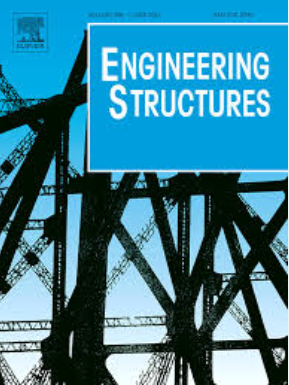Experimental and simulation study on seismic resilience in bridge piers affected by saline soil corrosion
IF 6.4
1区 工程技术
Q1 ENGINEERING, CIVIL
引用次数: 0
Abstract
By simulating a salt-laden soil corrosion environment, immersion corrosion tests on concrete specimens, rust tests on rebar, and regional immersion corrosion tests on bridge piers were conducted. The objective was to study the variations in the seismic performance of bridge piers across different corrosion cycles. In this study, four bridge piers underwent pseudo-static loading tests, three of which were subjected to corrosion, with the longitudinal rebar experiencing a maximum corrosion rate of 16.81 %. The OpenSees finite element platform was utilized to conduct simulated analyses of the bridge piers across different corrosion cycles, incorporating the mechanical performance test results of the corroded rebar and concrete after immersion. The findings suggest that the corrosion rate of the longitudinal rebar in the bridge piers throughout the same corrosion cycle did not deviate by more than 15 % from the results of the rebar rust tests. Differences in peak load under the same corrosion cycle between the experimental data and the numerical simulation results were no more than 7.7 %, which is considered an acceptable level of agreement. According to the simulation results, when the longitudinal reinforcement corrosion rate is less than 6.69 %, the corroded bridge piers have an initial stiffness that is 48.2 % higher than the uncorroded columns. However, as the corrosion rate continues to increase, the reinforcing effect of changes in concrete strength on initial stiffness diminishes due to the development of cracks in the protective layer. This finding is also supported by quasi-static experiments. To summarize, the seismic performance of the bridge piers declines as the corrosion cycle lengthens, showing a faster loss in the later phases compared to the uncorroded columns.
盐渍土腐蚀影响下桥墩抗震回弹性的试验与模拟研究
通过模拟含盐土壤腐蚀环境,对混凝土试件进行了浸没腐蚀试验,对钢筋进行了防锈试验,对桥墩进行了区域浸没腐蚀试验。目的是研究不同腐蚀周期下桥墩抗震性能的变化。在本研究中,4个桥墩进行了拟静力加载试验,其中3个桥墩发生了腐蚀,纵向钢筋的最大腐蚀速率为16.81 %。利用OpenSees有限元平台对不同腐蚀周期的桥墩进行模拟分析,结合锈蚀后钢筋和混凝土浸没后的力学性能测试结果。研究结果表明,在同一腐蚀循环中,桥墩纵向钢筋的腐蚀速率与钢筋锈蚀试验结果的偏差不超过15% %。在相同腐蚀循环下,实验数据与数值模拟结果的峰值荷载差异不超过7.7 %,这被认为是可接受的一致水平。仿真结果表明,当纵向钢筋腐蚀率小于6.69 %时,腐蚀桥墩的初始刚度比未腐蚀桥墩的初始刚度高48.2 %。然而,随着腐蚀速率的继续增加,由于保护层裂缝的发展,混凝土强度变化对初始刚度的增强作用减弱。这一发现也得到准静态实验的支持。总而言之,随着腐蚀周期的延长,桥墩的抗震性能下降,与未腐蚀的柱子相比,在后期阶段的损失更快。
本文章由计算机程序翻译,如有差异,请以英文原文为准。
求助全文
约1分钟内获得全文
求助全文
来源期刊

Engineering Structures
工程技术-工程:土木
CiteScore
10.20
自引率
14.50%
发文量
1385
审稿时长
67 days
期刊介绍:
Engineering Structures provides a forum for a broad blend of scientific and technical papers to reflect the evolving needs of the structural engineering and structural mechanics communities. Particularly welcome are contributions dealing with applications of structural engineering and mechanics principles in all areas of technology. The journal aspires to a broad and integrated coverage of the effects of dynamic loadings and of the modelling techniques whereby the structural response to these loadings may be computed.
The scope of Engineering Structures encompasses, but is not restricted to, the following areas: infrastructure engineering; earthquake engineering; structure-fluid-soil interaction; wind engineering; fire engineering; blast engineering; structural reliability/stability; life assessment/integrity; structural health monitoring; multi-hazard engineering; structural dynamics; optimization; expert systems; experimental modelling; performance-based design; multiscale analysis; value engineering.
Topics of interest include: tall buildings; innovative structures; environmentally responsive structures; bridges; stadiums; commercial and public buildings; transmission towers; television and telecommunication masts; foldable structures; cooling towers; plates and shells; suspension structures; protective structures; smart structures; nuclear reactors; dams; pressure vessels; pipelines; tunnels.
Engineering Structures also publishes review articles, short communications and discussions, book reviews, and a diary on international events related to any aspect of structural engineering.
 求助内容:
求助内容: 应助结果提醒方式:
应助结果提醒方式:


